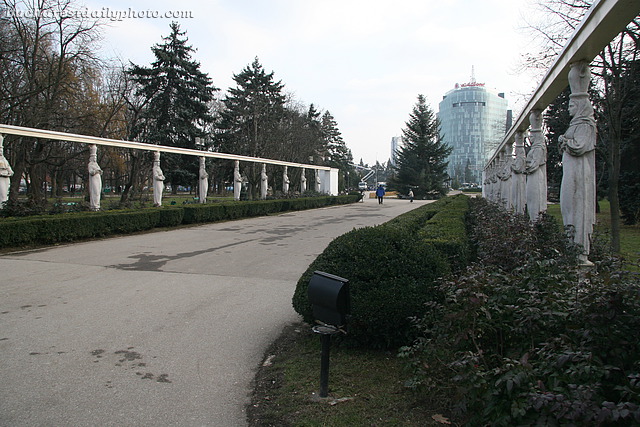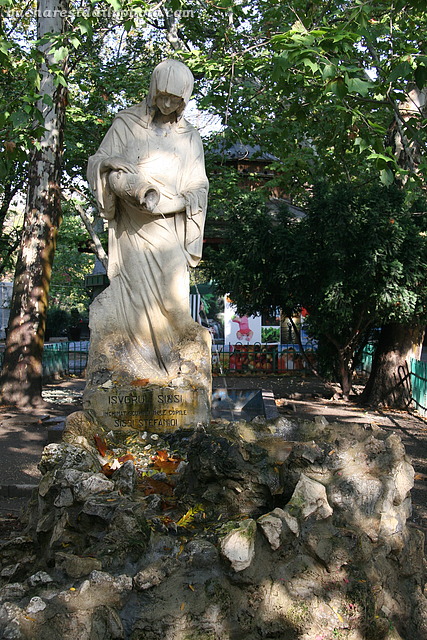This beautiful fountain is one of my favourite monuments in Bucharest and every time I find myself in Carol Park I make sure to pass by it. It was built in 1870 by George Grigore Cantacuzino who at the time was the mayor of Bucharest. This fountain replaced an older one, built in the 1792-1793 for tapping the water source that fed Filaret Hill. The older fountain deteriorated slowly and was demolished in 1863. The message written on the upper part of the fountain reads “This fountain was built in 1870 at the expense of the capital’s mayor, George Grigore Cantacuzino, following the vote by the municipal council of Bucharest held on August 8, 1869, when it was decided that the fountain will bear the name of George Grigore Cantacuzino Fountain”. The fountain, built in neoclassical style, is decorated with bass-reliefs representing medieval knights and coats of arms.
Because one of the photos from the “Winter in the park” series has raised some questions I decided to show the entire work of art that contains that statue, work that was clipped by my framing. The ensemble is called “The Alley of the Cariatides” by Constatin Baraschi (November 17, 1902 – March 22, 1966) and consists of two strings of 10 statues on each side of the alley. The statues represent Romanian peasant women, dressed in traditional clothing and carrying an amphora on their heads. There are two types of statues and they are differentiated by the position of their hands. The work was unveiled in 1936 but what we see today is not the original, which was destroyed during communism to make space for a statue of Stalin, but a reconstruction done in 2005 using the original molds. I don’t know how correct this information is but I’ve also read on the web that “The Alley of the Cariatides” caused quite a stir when it was originally unveiled, stir determined by two facts: first, that this was a classical arrangement but the subjects were peasants and second, the fact that the peasants were barefoot.
And finally I present to you the last photos in the snow series, all taken two days ago in my favourite park, Cişmigiu. Looks like the subzero cold wasn’t enough to keep people from coming to the park. Lots of folks were out and about strolling the alleys; it’s true that nobody was sitting on the benches for a chat 🙂 I’ve met quite a few fellows with their cameras and even compared photo equipment with a couple (they had a Nikon while I’m part of the Canon team). As you can see in the above photo, someone was feeding the pigeons just as I entered the park. Here comes the rest:
Taking a stroll
Statue of Ion Creangă, Romanian writer
This evening I took a stroll downtown to check out this year’s Christmas decoration. I snapped quite a few pictures and this presented me with a problem: I couldn’t decide which photo I like best. For this reason for today Bucharest daily photo will transform in Bucharest daily photos. I might also “bore” you with this theme for the next two or three days (maybe). Today’s photos were taken in and around Cişmigiu Park. The park was full of people curious to check out the decorations. Everybody was snapping pictures so this time I wasn’t the only one carrying a camera. The photo above is Bucharest’s City Hall located right across from Cişmigiu Park.
The entrance to the park:
The last two photos are showing customs that are not traditional Romanian, but were imported from Western Europe in the last years: the nativity scene and the Christmas market.
If one lives in a hectic city like Bucharest one tends from time to time to seek out the places of peace and quiet where one can take a short break from all the noise and the never ending chaos. That is why Bucharest’s parks are some of the favourite places to go for the city’s residents. While Bucharest’s bigger parks are all located in residential neighbourhoods, a bit farther away from the city center, small parks exist right in the center of the city. There’s Cişmigiu Park, which I already talked about, there’s Ioanid Park that I still have to show you, and there’s the little park that is the subject of today’s photo, which is called Cazzavillan Park. Located in a residential area, north of Ştirbei Vodă, at the crossing of Luigi Cazzavillan and Temişana and Transilvania streets, the park, set out in 1905,was completely renovated in 2005. The park bears the name of an Italian journalist, Luigi Cazzavillan (1852-1903), who came to Romania in 1877 as a war correspondent and decided to stay. At first Cazzavillan worked as an professor of Italian, but in 1884 he founded the newspaper “Universul”, which became one of the most famous and most influential daily newspapers in Romania. That is why, in the middle of the park you’ll find the little Luigi Cazzavillan fountain, made in the journalist honor, topped by Cazzavillan’s bust surrounded by putti. The fountain dates from 1905 and its author is sculptor Filip Marin (1865-1928). There isn’t a wikipedia page about Luigi Cazzavillan but on youtube I was able to find this short archive film showing a Romanian delegation that visited Arzignano (Vicenza) to honor the memory of the journalist.
Today’s photo shows another beautiful sculpture in Cişmigiu Park, the Monument of the French Soldiers, which honors the French soldiers who died on Romanian soil during the First World War. It seems to be the most popular monument in the park cause every time I pass by I see people taking pictures of it. It depicts a French soldier dying in the arms of a Romanian peasant woman. It was unveiled in October 1922 in the presence of French Marshal Ferdinand Foch. The sculptor Ion Jalea, a war veteran himself, was awarded the “National Order of the Legion of Honour”, the highest decoration in France.
Cişmigiu Park is one of my favourite places in Bucharest. In my college days I used to stroll these paths almost every day, hand in hand with my sweetheart, talking about our plans and the world as we saw it through the eyes of two 20 year olds. Back in those days I used to spend a considerable amount of time in Cişmigiu. After I graduated and started to work, I rarely found the time to go to the park. But since starting this blog I’ve been passing through Cişmigiu a lot, in search for subjects to photograph. I always find something worth photographing there, like the black swan or the patriotic benches that I showed to you on previous posts. Cişmigiu has some nice landmarks or points of attraction which I have yet to photograph so I have plenty of reasons to return to the park. Today’s photo shows one of these landmarks, “The Sissi Spring”. This beautiful statue was created by the sculptor Dimitriu Bârlad (1890-1964) and depicts a mother mourning the death of her daughter, pouring water from a pitcher. The engraving reads “Dedicated to my beloved daughter Sissi Stefanidi”.
I wonder if the intention in painting these benches in Cişmigiu Park in red, yellow and blue was to make them look like the Romanian flag? In this case they should be grouped in threes rather than twos.
Roughtly about two months ago I saw work being done on the southeast corner of the University Square, the one with Colţea Hospital and the Ministry of Agriculture building. Knowing that the little park was renovated only about two years ago I asked myself, as I’m sure many of my fellow citizens did, “Why are they renovating this corner again?”. Turns out they were repairing the fountain and installing a giant bronze violin, a work of artist Ioan Bolborea made after a project by the Italian artist Domenica Regazzoni. Domenica Regazzoni has a series of violins, the one installed in Univeristy Square being “The broken violin”. Sculpture aside, I really like this little corner of peace right in the heart of such a chaotic city as Bucharest. It’s a great place to sit on a bench and watch the world go by.
Busy day today, no time to write a lengthy post. I’ll see you all tomorrow. Until then I leave you in the company of this lovely creature, which I photographed in Cişmigiu Park.























